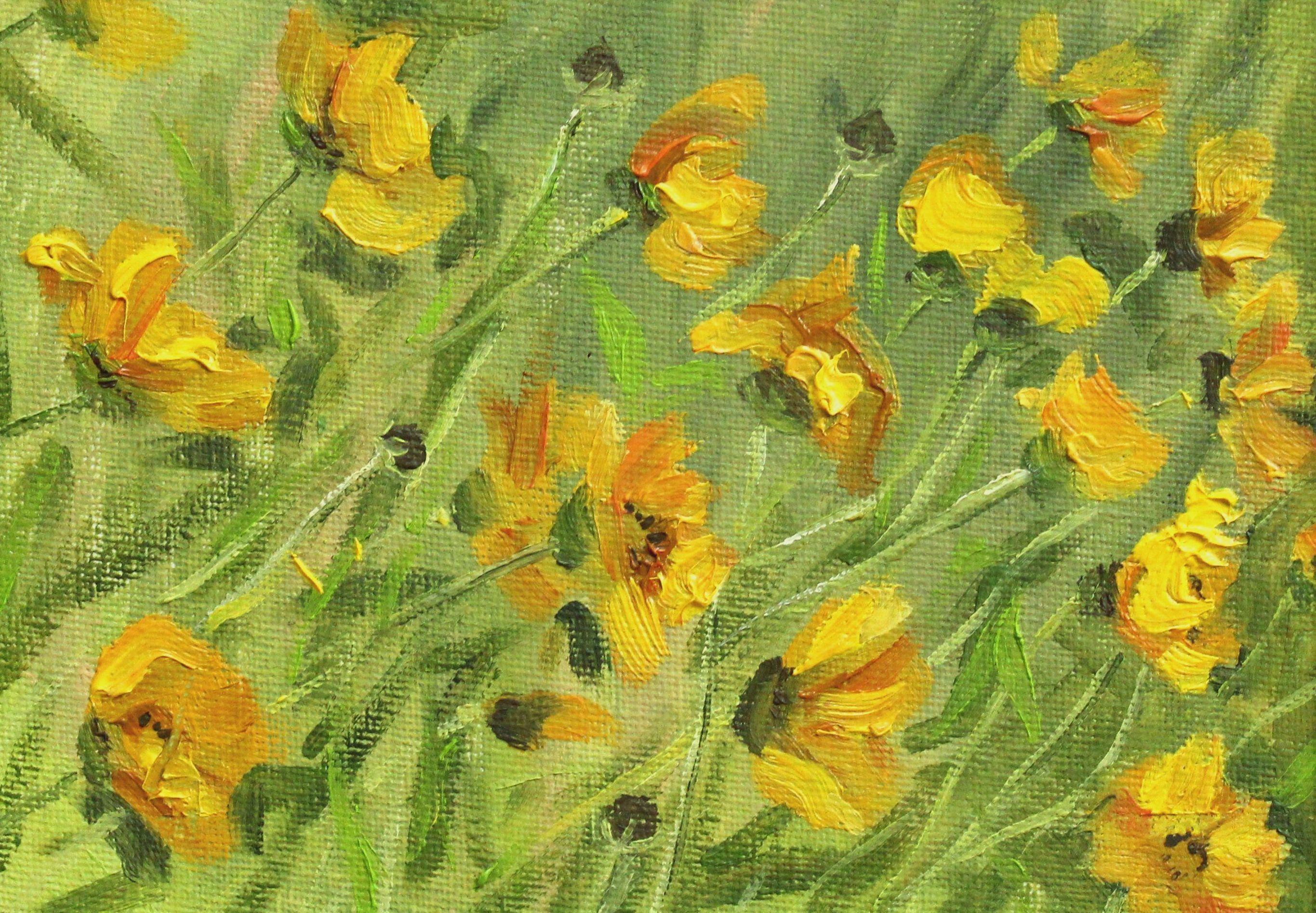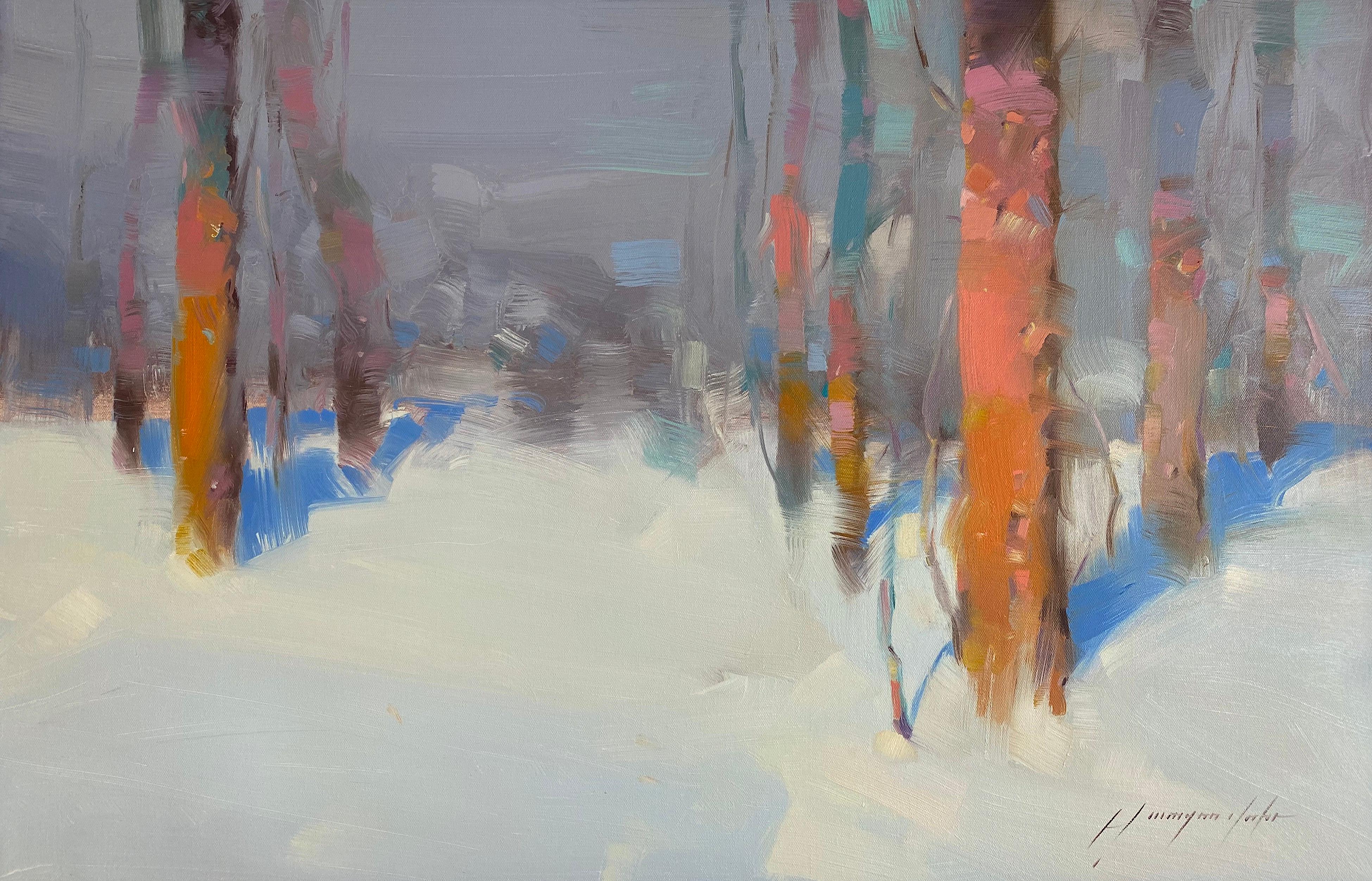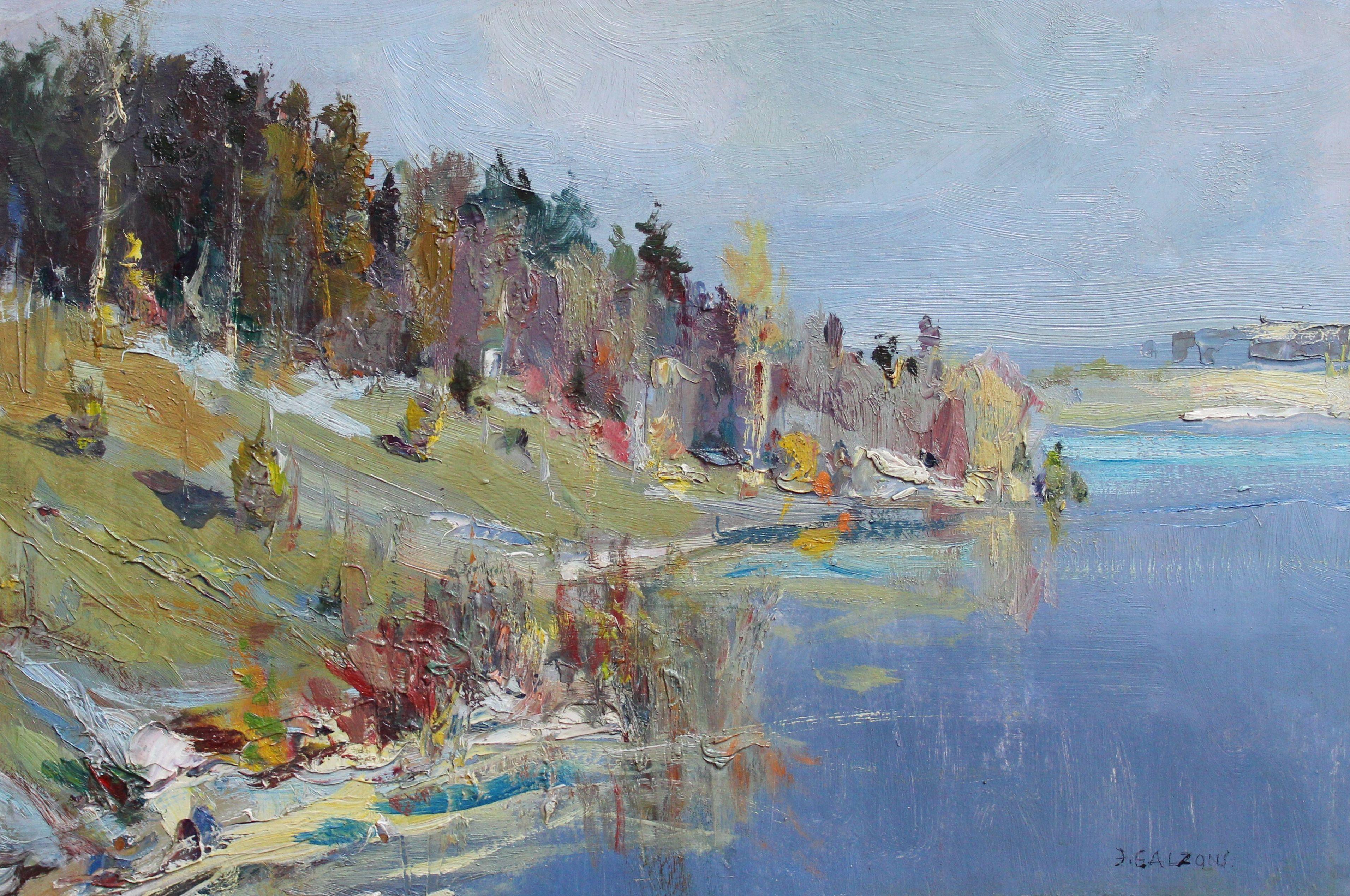Items Similar to Crossing the Common French 19thC art figurative windmill landscape oil painting
Want more images or videos?
Request additional images or videos from the seller
1 of 12
Georges MichelCrossing the Common French 19thC art figurative windmill landscape oil paintingCirca 1835
Circa 1835
About the Item
This superb French 19th century figurative landscape oil painting with excellent provenance is by noted French artist Georges Michel. Painted circa 1835 it is entitled verso Crossing the Common. The painting depicts an expansive flat landscape with a windmill and trees to the right. In the foreground a mother, in a red dress and child are walking along a path towards the windmill and away from the viewer and artist. The foreground is bathed in light under a blustery looking sky. Michel always painted within a small area limited to the surroundings of Paris. His preferred locations were Montmartre, where he was inspired by the famous windmills, the plains of Saint-Denis, the villages ofVaugirard, Grenelle, Montsouris, Romainville and Le Pré-Saint-Gervais so this is likely to be one of those locations, perhaps the plains of Sant-Denis. Michel developed a very personal vision, in which light and treatment of the sky and space became his principal concern. His paintings became more unified compositionally, with vast expanses of landscape and wide perspectives under stormy skies. The windmills are often the sole accents punctuating the compositions. After 1830 he was at the peak of his talent. His style became even more lyrical and visionary, his brushstrokes broader and his paint thicker. This painting is an excellent example of all of the above.
Provenance: The collection of James S. Forbes Esq. His sale, May 23 1874, Christie's lot 119
Bought by Thomas Agnew & Sons for George Salting Esq.Sale,
Christie's, Sir Thomas Devitt, 16 May 1924, lot 139
Derrick Warden Milligan (d. 1974)
Thence by family descent
Various labels verso.
Condition. Oil on paper laid on canvas, image size 22 inches by 18 inches, in good condition.
Frame. Housed in an ornate gilt frame, 30 inches by 26 inches, in good condition.
Georges Michel (1763-1843). Michel was born in in Paris. He came from a humble background, his father being an employee at the market of Les Halles. At an early age, Michel worked on a farm in the Saint-Denis region, north of Paris, where he first developed his interest in the countryside. In 1775, he was apprenticed to a mediocre history painter, but he preferred to sketch outdoors. A colonel of the Hussars engaged him in his regiment, garrisoned in Normandy, and arranged for him to take further lessons. Michel remained there for more than a year, after which he returned to Paris. Later in 1798, Michel left for Switzerland, and also visited Germany. The art dealer Jean-Baptiste-Pierre Le Brun authorized Michel to copy the seventeenth century Dutch paintings that were in his shop, and was, in a way, very responsible for the artist’s further artistic development. In 1791 Michel debuted at the Salon, where he continued to exhibit regularly. Nevertheless, critics ignored Michel, considering his works too similar to those of the Dutch masters. Around 1800, Michel was employed by the Musée du Louvre to restore their Flemish and Dutch paintings, and it was in this capacity that he developed a true understanding of the technique of his predecessors. In 1808, he decided to set up a studio and give lessons, but he stopped teaching the following year. In 1813 he opened a shop adjacent to his studio and sold furniture and paintings. He exhibited for the last time at the Salon of 1814. After the death in 1820 of the last surviving of his eight children, he left Paris to stay for one year in Picardy. After his return, he began to live a reclusive life and gradually withdrew from the art world. Because of his self-imposed artistic isolation, Michel had to rely solely on the patronage of the Baron d’Ivry, who purchased almost his entire output until 1830, when the two men had a falling out over political differences. Michel always painted within a small area limited to the surroundings of Paris. He commented that ‘whoever cannot paint within an area of four leagues is but an unskilled artist who seeks the mandrake and will only ever find a void.” His preferred locations were Montmartre, where he was inspired by the famous windmills, the plains of Saint-Denis, the villages ofVaugirard, Grenelle, Montsouris, Romainville and Le Pré-Saint-Gervais. His small plein air studies were often drawings heightened with watercolor wash, which were then used as preliminaries for paintings worked up in the studio. His career can be divided into three phases. The first, until circa 1808, includes the period of his collaboration with Jean-Louis Demarne and Jacques-François Swebach, artists who often executed the staffage of his landscapes. Later he developed a more personal vision, in which light and treatment of the sky and space became his principal concern. His paintings became more unified compositionally, with vast expanses of landscape and wide perspectives under stormy skies. The windmills are often the sole accents punctuating the compositions. After 1830 he was at the peak of his talent. His style became even more lyrical and visionary, his brushstrokes broader and his paint thicker. He reinforced the dramatic tension by accentuating the heaviness of the skies and the contrasts of light and dark. Michel had little interest in fame, and with the exception of a few early paintings, his works are unsigned. Michel meant that the quality of the painting should speak to the beholder, and not the signature. He never achieved success during his lifetime and in 1841, two years before his death, the contents of his studio, consisting of more than 1000 studies and 2000 drawings, were put up at auction. The Barbizon painter Charles Jacques acquired several of his works, and other artists from this group, like Jules Dupré, were much inspired by Michel. His importance is more as a precursor of the works of the Barbizon school, while his own oeuvre has not yet been given the full attention that it deserves.
Selected Museum Collections:
Amiens; Baltimore, Walters Art Museum; Bayeux; Beauvais, Musée départemental de l’Oise; Béziers; Bordeaux, Musée des Beaux-Arts; Boston, Museum of Fine Arts; Brest; Buffalo, NY, Albright-Knox Art Gallery; Carpentras; Chicago, Art Institute of Chicago; Cleveland Museum of Art; Dijon, Musée Magnin; Hanover; The Hague, Museum Mesdag; Lille, Musée des Beaux-Arts; London, Courtauld Institute; London, National Gallery; Lyon, Musée des Beaux-Arts; Madrid, Thyssen-bornemisza Museum; Nantes; New York, Metropolitan Museum of Art; Paris, Musée du Louvre; Pontoise; Portland Art Museum; Rennes, Musée des Beaux-Arts; St. Petersburg, Hermitage; State College, PA, Palmer Museum of Art; Strasbourg; Valenciennes, Musée des Beaux-Arts..
- Creator:Georges Michel (1763-1843, French)
- Creation Year:Circa 1835
- Dimensions:Height: 26 in (66.04 cm)Width: 30 in (76.2 cm)Depth: 2 in (5.08 cm)
- Medium:
- Movement & Style:
- Period:
- Condition:
- Gallery Location:London, GB
- Reference Number:1stDibs: LU853114375122
About the Seller
5.0
Platinum Seller
These expertly vetted sellers are 1stDibs' most experienced sellers and are rated highest by our customers.
1stDibs seller since 2018
402 sales on 1stDibs
Typical response time: 1 hour
- ShippingRetrieving quote...Ships From: London, United Kingdom
- Return PolicyA return for this item may be initiated within 14 days of delivery.
More From This SellerView All
- Celebrations at Marienplatz, Munich French 1900 art city landscape oil paintingBy Jacques Emile BlancheLocated in London, GBThis superb French Impressionist city landscape oil painting is attributed to Jacques Emile Blanche and has his characteristic brushwork. It was painted circa 1900 and portrays a civ...Category
Early 1900s Impressionist Landscape Paintings
MaterialsOil
- Italian Landscape - British 19thC art Impressionist oil painting female artistBy Susan Isabel DacreLocated in London, GBThis Italian landscape is an oil on canvas, framed behind glass in its original gallery frame, by Susan Isabel Dacre. A superb painting, painted circa 1888. Dacre was an early member of the Feminist movement and a member of the Manchester arts community. She travelled with Lord Leighton and exhibited widely. This work shows influences of early British impressionism. The painting depicts an Italian landscape with a road sweeping around a hill with dwellings and trees. The brushwork and palette are superb. An excellent example of a 19th century women artists work. Signed lower left. Provenance. Family collection. Condition. Oil on canvas. Image size 13 inches by 10 inches. canvas in original excellent condition. Housed in an original gilt frame 20 inches by 17 inches approx. and in good condition. Susan Isabel Dacre (1844 – 1933) was an English female artist of the Victorian era. She was born in Leamington, Warwickshire, and was educated in Salford. For the decade of 1858–68 she lived in Paris. After a winter in Italy (1869), she returned to Paris, and was present during the Franco-Prussian War and the Paris Commune. She returned to England in 1871 and began studying art at the Manchester School of Art, where she won the Queen's Prize in 1875. She began a lifelong friendship with fellow artist Annie Swynnerton; the two women pursued their art studies in Rome and Paris between 1874 and 1880. Around 1872, Lord Leighton dictated notes and observations on his methods of painting and composing his pictures to Susan Dacre during a stay on the island of Capri. From 1877-1880 she was in Paris at the Académie Julian with a fellow - pupil Marie Bashkirtseff...Category
19th Century Impressionist Landscape Paintings
MaterialsOil
- Chanctonbury Ring - Scottish Glasgow Boy art RA exh 1933 landscape oil paintingBy George HenryLocated in London, GBThis superb Scottish Impressionist Royal Academy exhibited landscape oil painting is by noted Scottish Glasgow Boy artist George Henry. He influenced the Glasgow School towards a ric...Category
1930s Impressionist Landscape Paintings
MaterialsOil
- Summer Afternoon Firth of Clyde - British exh figurative seascape oil paintingLocated in London, GBThis lovely Scottish exhibited seascape oil painting is by noted Scottish artist Patrick Downie. It was painted in 1914 and exhibited at the Glasgow Institute of Fine art that year e...Category
1910s Impressionist Landscape Paintings
MaterialsOil
- The Anastasia - Scottish Impressionist 1911 Norwegian marine art oil paintingBy James Campbell NobleLocated in London, GBA fine oil on canvas by Scottish listed artist John Campbell Noble RSA. Painted circa 1911 it is a fine example of Scottish Impressionism and depicts a river/marine landscape with ...Category
1910s Impressionist Landscape Paintings
MaterialsOil
- Tiree Coastal Landscape Scotland - Scottish Impressionist Edwardian oil paintingBy Joseph Morris HendersonLocated in London, GBThis serene Scottish Impressionist Edwardian coastal landscape is by noted Scottish artist Joseph Morris Henderson. It was painted circa 1910 and entitled Tiree verso. Tiree is the most westerly island in the Inner Hebrides of Scotland and one of the sunniest places in Scotland as well as midge fee due to the stiff breeze. Tiree is a very popular windsurfing venue and sometimes referred to as the Hawaii of the north. In most years, the Tiree World Classic surfing event is held here. The exact location of the painting is probably Vaul beach. Henderson has painted the view from one side of the large sweeping bay, so one looks across the beach to the opposite headland. His palette of light turquoise blues of the sea is just beautiful with the dramatic blusterly clouds above the sunny beach. The brushwork and impasto as just superb. This is a wonderful sunny Scottish coastal landscape and a superb example of Henderson's work. Signed lower right. Provenance. Signed and titled on T. & R. Annan & Sons, Ltd., Glasgow verso. Condition. Oil on canvas. Image size 24 inches by 18 inches and in good condition. Frame. Housed in a frame that compliments the picture, 31 inches by 25 inches and also in excellent condition. Joseph Morris Henderson (1863-1936). Born in Glasgow, son of the artist Joseph Henderson by whom he was strongly influenced. Studied at Glasgow University and Glasgow School of Art. His style absorbed much from romantic Victorian realism and he dedicated himself to landscapes, seascapes and coastal scenes. He exhibited throughout his life primarily in Scotland. He was elected an Associate member of the Royal Scottish Academy in 1928 and a full member in 1935. He exhibited there from 1890 for nearly fifty years, exhibited approximately 80 paintings.Category
1910s Impressionist Landscape Paintings
MaterialsOil
You May Also Like
- BreezeLocated in Zofingen, AGIn this piece, I've poured my heart into an abstract symphony of color and emotion, utilizing acrylics, oil, and oil pastel to craft a textured, layered work. It's a narrative withou...Category
2010s Impressionist Interior Paintings
MaterialsCanvas, Oil, Acrylic
- "Winter, Illuminated brook" Oil, cm. 96 x 84By Georgij MorozLocated in Torino, ITWinter, Snow, Mountain, Cold, White,Purple, lilac Label on the back Galleria Pirra Torino Published in a monographic catalogue Georgij MOROZ (Dneprodzerzinsk, Ucraina, 1937 - St. P...Category
Early 2000s Impressionist Landscape Paintings
MaterialsCanvas, Oil
- "Feeling Roostery!" signed oil bird kiche farm outdoors restaurant kitchen calmBy Cathryn RuvalcabaLocated in Milwaukee, WI"Feeling Roostery!" is an original oil painting by Cathryn Ruvalcaba. Here, she depicts a colorful rooster strutting though a green pasture. Cathryn paints in the Russian Impressioni...Category
2010s Impressionist Animal Paintings
MaterialsBoard, Oil
- Flowers of the sun. 2023, canvas, cardboard, oil, 13x18 cmLocated in Riga, LVFlowers of the sun. 2023, canvas, cardboard, oil, 13x18 cm Small size plein air painting Alyona Prokofyeva (1988) From 2016 surname Galaktionova....Category
2010s Impressionist Landscape Paintings
MaterialsOil, Cardboard, Canvas
- Winter, Original oil Painting, Ready to HangBy Vahe YeremyanLocated in Granada Hills, CAArtist: Vahe Yeremyan Work: Original Oil Painting, Handmade Artwork, One of a Kind Medium: Oil on Canvas Year: 2021 Style: Impressionism, Subject: Winter, Size: 20.5" x 31.5" x 0...Category
2010s Impressionist Landscape Paintings
MaterialsOil, Canvas
- The river in the summer. Cardboard, oil, 32x49 cmBy Janis GalzonsLocated in Riga, LVThe river in the summer. Cardboard, oil, 32x49 cmCategory
1980s Impressionist Landscape Paintings
MaterialsCardboard, Oil
Recently Viewed
View AllMore Ways To Browse
Antique Art Sale
Paris Art Dealers
Antique Painting Unsigned
Antique Shop Drawing
Vision Antique
Antique Oil Painting Red
Antique Frames Lot
Swiss Style Paper Art
Musee De Louvre
Antique Studio Light
Art Auction Sale
Saint George Painting
Ornate Framed Landscape Art
Montmartre Oil Painting
Art Four Antiques
Montmartre Frame
Oil Paintings Of Montmartre
The Windmill





